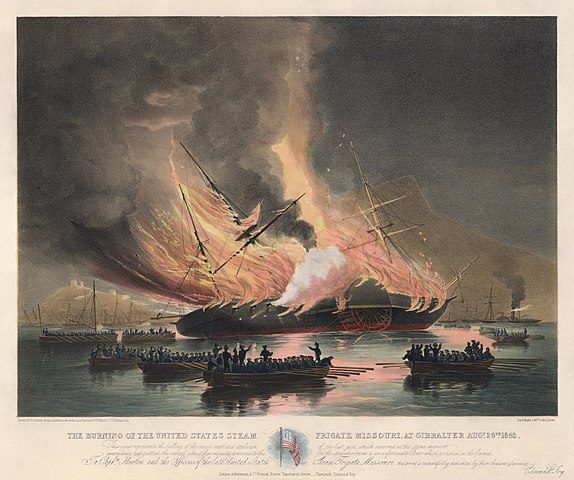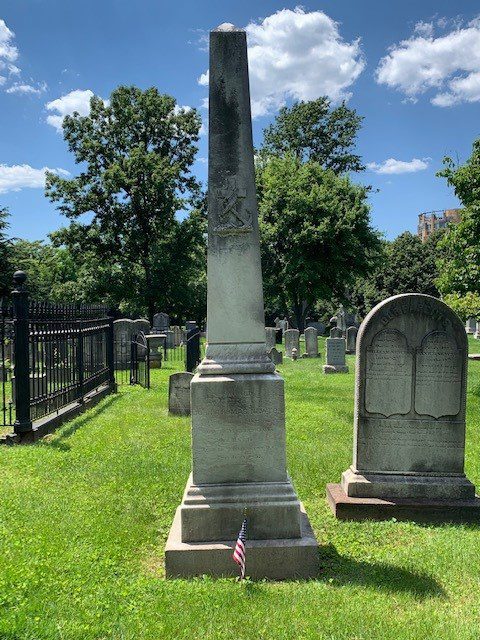John Thomas Newton, born on May 20, 1794, and passing away on July 28, 1858, finds his final resting place in Alexandria’s Presbyterian Cemetery. A distinguished figure in the early history of the United States Navy, Newton’s legacy is etched in his remarkable 48-year service to the nation, commencing in 1809.
Notably, he held the esteemed rank of Lieutenant aboard the USS Hornet, a ship that played a pivotal role in the War of 1812 by successfully sinking the HMS Peacock off the South American coast. As a testament to his courage and valor, the US Congress bestowed upon him a Silver Medal, while the ship’s commander, Captain James Lawrence, received a Gold Medal for his contributions.
In recognition of his exceptional heroism during the War of 1812, the citizens of Alexandria also honored John Thomas Newton with a symbolic gift – a sword, symbolizing his dedication and service to his country.
USS Missouri (1841)
In 1841, John Thomas Newton assumed command of the USS Missouri, a steam frigate side-wheeler, setting sail on a crucial mission to transport American Ambassador Caleb Cushing to Gibraltar—this journey aimed to initiate negotiations for the first commercial treaty with China.

Tragic Fire in Gibraltar.
Tragically, disaster struck on the night of August 26, 1843, shortly after the ship’s arrival in Gibraltar on August 25. A crew member accidentally broke and ignited a container of turpentine in the storeroom, leading to a rapid and devastating fire that engulfed the USS Missouri. With no recourse but to abandon the ship, the crew faced a perilous situation.
In a stroke of luck, Ambassador Cushing managed to salvage his official letter to the Daoguang Emperor of China, preserving the critical document and enabling him to fulfill his mission at a later time.
Regrettably, the incident led to a court-martial for John Thomas Newton, who was held responsible for the calamitous events aboard the USS Missouri. Consequently, he was dismissed from the Navy. This incident had a lasting impact on the US Navy, as it established the tradition of holding the ship’s Captain ultimately accountable for all occurrences onboard.
Death and Burial
Subsequently, he made his way back to the Navy, where he achieved the rank of Commodore. Tragically, while still dutifully serving in Washington, he breathed his last. In another aspect of his life, his sister entered into matrimony with the Wise family, renowned for their active engagement with Alexandria’s Presbyterian Meeting House.

| Sacred to the memory of JOHN THOMAS NEWTON commodore U.S.N. born in Alexandria, VA 20th May 1794 died in Washington, DC 28th July 1857 Entered the Navy in 1809, was an officer in active service during the war of 1812 and died while in the performance of his duty and celebrated 48 years of his life to the service of his Country |
Sources of Information
The Alexandria Association April 12- May 12, 1956. Our Town 1749-1865 at Gadsby’s Tavern Alexandria, Virginia. The Dietz Printing Company. 1956.
Pippenger, Wesley E. Tombstone Inscriptions of Alexandria, Virginia: Volume 1, Family Line Publications, Westminster, MD, and Heritage Books, Inc., Bowie, MD. 1992.
Van Horn, Hugh M. The Presbyterian Cemetery Alexandria, Virginia 1809 – 2009. The Arlington Press, Arlington, Virginia for the Old Presbyterian Meeting House. 2009.
Dahmann, Donald C., Archivist, Old Presbyterian Meeting House member. The roster of Historic Congregational Members of the Old Presbyterian Meeting House. Updated 2022.